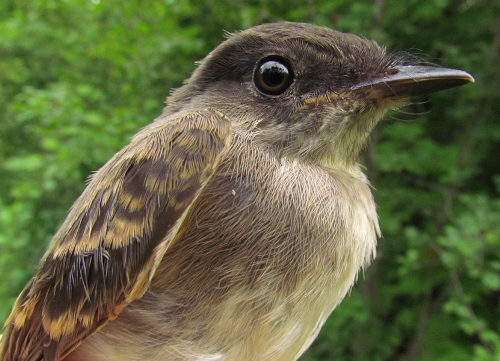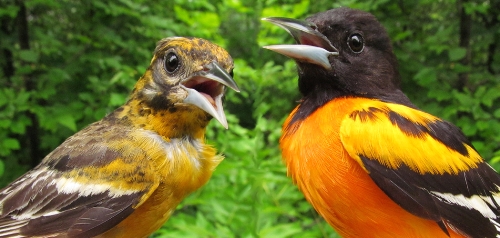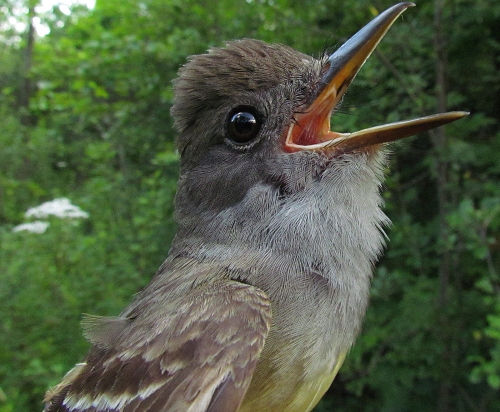Summer 2013 (June 6 – July 31)
PICTURE OF THE SEASON: |
|
|
| MAPS SEASON | NEST BANDING | 2013 TOTAL | SITE TOTAL | |
|---|---|---|---|---|
| # birds (and species) banded | 137 (30) | 13 (2) | 1295 (77) | 42087 (112) |
| # birds (and species) repeat | 33 (9) | — | 330 (36) | 8311 (70) |
| # birds (and species) return | 18 (11) | — | 155 (29) | 1364 (38) |
| # species observed | 56 | — | 150 | 208 |
| # net hours | 378.0 | — | 3356.8 | 72646.5 |
| # birds banded / 100 net hours | 36.2 | — | 38.6 | 58.9 |
Bander-in-charge: Lisa Keelty
Assistants: Emily Boulanger, Marcelo Brongo, Simon Duval, Gay Gruner, Alison Hackney
Monitoring Avian Productivity and Survivorship (MAPS), Summer 2013
For the fifth year in a row, MBO’s summer program followed the MAPS protocol. It is a breeding-season study, with banding taking place on a single day during each of seven consecutive ten-day periods falling within MBO’s summer season of June 6 to July 31. The first five periods coincide with the “adult superperiod” (i.e. typically dominated by breeding adults) and the last two with the “young superperiod” (i.e. usually dominated by juveniles). To reduce overlap with our migration monitoring programs, we do not use our 16 migration-monitoring nets; rather we use nine nets placed around the southern end of Stoneycroft Pond. In addition to operating mist nets, observers gather breeding bird evidence on all species heard or seen during each banding day.
|
|
This year we banded 137 individuals of 30 species; the number of birds is close to average for MAPS, but the diversity is the second highest after last year, and well above the average over the first five years of the program. An additional 9 nestlings from nest boxes were banded – 4 Tree Swallows and 5 Eastern Bluebirds. Unlike last year when a wave of early migrating Yellow Warblers caused a spike in numbers, this year’s results appear to have largely reflected the local breeding population. Like in 2010, the final session of the season was the most productive, in this case with 52 individuals banded; combined, the two sessions during the young superperiod accounted for over half of the birds banded during MAPS this summer.
| # individuals banded | mean # individuals observed |
|---|---|
| Song Sparrow (29) [2] | 1. Red-winged Blackbird (17) [2] |
| 2. Gray Catbird (14) [-] | 2. Cedar Waxwing (15) [6] |
| 3. American Robin (11) [3] | 3. Common Grackle (8) [-] |
| 3. Red-winged Blackbird (11) [7] | 4. American Goldfinch (8) [6] |
| 5. Veery (8) [-] | 5. Black-capped Chickadee (7) [2] |
| 5. Yellow Warbler (8) [1] | 6. European Starling (6) [-] |
| 7. Warbling Vireo (7) [5] | 7. American Robin (6) [5] |
| 8. Great Crested Flycatcher (5) [-] | 7. Song Sparrow (6) [4] |
| 9. Red-eyed Vireo (4) [6] | 9. Blue Jay (5) [-] |
| 9. American Redstart (4) [-] | 10. American Crow (4) [9] |
Song Sparrow reclaimed the top spot among species banded, with 29 – more than double the number of Gray Catbirds in second place, although both species set new records for summer (previously 26 Song Sparrows in 2012 and 6 Gray Catbirds in 2011). All but two of the catbirds were banded in the final session and most were juveniles, reflecting a good breeding year on site. The Veery count this year was also unusually high, double the previous record of 4 banded in summer (in 2009 and 2010). For the first time ever, Great Crested Flycatcher made the top ten list for summer, with five individuals all banded on July 14, all of which, surprisingly, were adults. American Redstart also appears in the top ten for the first time, suggesting a stronger breeding presence than in most previous years. One of the biggest surprises was that only one Black-capped Chickadee was banded during this year’s MAPS program even though it was observed on each visit, and was among the top ten species banded in all previous years.
Two species were banded for the first time in summer: Eastern Phoebe and Blue Jay. This brings the count of species banded at MBO in summer to 45. Brown Thrasher and Brown-headed Cowbird were both banded again in 2013 after being new additions in 2012.
This year we had a record 18 returns (birds banded in previous years) of 11 species, including 5 that had not previously been returns in summer (Hairy Woodpecker, Warbling Vireo, American Robin, Cedar Waxwing, and American Goldfinch). In addition, we had a record 33 repeats (birds banded or last recaptured within the previous three months) of 9 species.
Over the seven sessions, 56 species were observed, the same number as last year, and slightly above average for the 5 years of MAPS. Of these, 14 (25%) were recorded on each visit: Red-eyed Vireo, Blue Jay, Black-capped Chickadee, House Wren, American Robin, Cedar Waxwing, Common Yellowthroat, Song Sparrow, Swamp Sparrow, Northern Cardinal, Red-winged Blackbird, Common Grackle, Baltimore Oriole, and American Goldfinch. Collectively, these represent most of the common breeding birds at MBO.
|
|
Because the focus of MAPS is on recording data from captured birds and there is extra urgency in processing breeding adults quickly, there is somewhat less emphasis on observations than in other seasons. Nevertheless, the observations reflect a fair degree of consistency between years, as seven of this year’s top ten species were also in last year’s top ten. Last year, Yellow Warbler was the species observed in the greatest numbers in summer, although largely due to the big wave of early migrants that moved through during the sixth session. This year, numbers were below normal, with a mean of only 3 individuals per visit, not enough to make this year’s top ten. Instead, Red-winged Blackbird dominated, followed closely by a record number of Cedar Waxwings. Common Grackles and Blue Jays were also present in record numbers this summer, while there were more American Goldfinches and European Starlings than any summer since 2008.
The number of birds banded during MAPS is relatively modest compared to other programs at MBO, and between heat and mosquitoes, the conditions are often somewhat uncomfortable. However, part of the strength of MAPS is that it is a continent-wide program coordinated by the Institute for Bird Populations, allowing for local results to be part of a much bigger picture. Among other things, MAPS data can be used to model vital rates (i.e. reproduction and survival) for each species, at a variety of geographic scales. We therefore plan to continue with MAPS again next summer. For now though, we look forward to more migrants coming through MBO as part of the Fall Migration Monitoring Program.
|
|
 The first Eastern Phoebe ever banded at MBO in summer, one of the offspring of a local nesting pair. (Photo by Lisa Keelty)
The first Eastern Phoebe ever banded at MBO in summer, one of the offspring of a local nesting pair. (Photo by Lisa Keelty) A five-year comparison of the number of individuals banded per session during the MBO MAPS season, showing a generally consistent pattern except for a dramatic spike in the sixth session for 2012.
A five-year comparison of the number of individuals banded per session during the MBO MAPS season, showing a generally consistent pattern except for a dramatic spike in the sixth session for 2012.  A pair of Baltimore Orioles, a second-year female at left and an after-second year male at right. (Photo by Lisa Keelty)
A pair of Baltimore Orioles, a second-year female at left and an after-second year male at right. (Photo by Lisa Keelty)  One of a record five Great Crested Flycatchers banded this summer. (Photo by Lisa Keelty)
One of a record five Great Crested Flycatchers banded this summer. (Photo by Lisa Keelty)